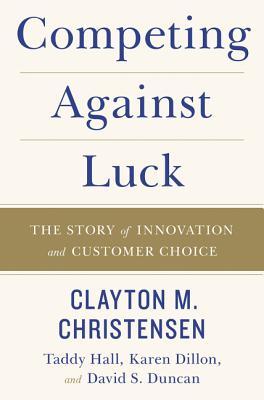Why are you in this or that business?
Very few of us venture into a business just because we want to look good and make money; the truth is that we do it or found a company because we find a niche that we can serve and we get paid. This is the business 101: you provide a valuable service or product that people are willing to pay for.
Essentially, this is the central thesis of Clayton Christensen’s latest book, Competing Against Luck.

As a Harvard Business School professor, Christensen packages the whole business 101 into fanciful theory called “Jobs to be done” theory; what jobs do your customer hire your products to do? The book comes with case studies on how he applies this theory in order to identify and solve customer needs.
Truth to be told, I have no qualms about the “Jobs to be done” theory proposed by Christensen; basically it is just a rehash of business 101: you have to provide valuable service/products that people are willing to pay for, and understanding what are the jobs your customers hire your products for is a necessary prerequisite to provide valuable products.
What I do find hard to swallow is the grandiose claim that this “Jobs to be done” theory makes innovation predictable, and that this theory is being sold as a panacea to anyone, whether you are an established entrepreneur or just a wannabe entrepreneur ( wantrepreneur), as if it should be treated on par with scientific theory. To me any kind of management theory is at best a descriptive ( and not prescriptive) framework, and can never “solve” innovation once and for all.
First, unlike scientific theory, whereby the subject studied cannot react against your theory( ie: the act of studying the cosmic system will not change it one little bit), management or social science theory can and do react against your theory, and tend to be self-defeating once it is popular enough. If you have a secret system that can beat the market, the moment it becomes a well known theory, it ceases to become useful. Similarly, any innovation theory that can result in predictable breakthrough will democratize “breakthrough” and make it more common. By definition, this is no longer a “breakthrough”.
Secondly, there are practical difficulties in applying this theory. This theory requires you to have a product that you can study how it is being used in the field and further iterate upon it, but a lot of times, wantrepreneur who starts with nothing simply doesn’t have this luxury. Wantrepreneur just have an idea and no product, so he can’t ask his customer for feedback. The quandary facing a wantrepreneur is a chicken-egg one; without customer feedback he can’t design the product, without the product he can’t obtain customer feedback. “Jobs to be done” theory doesn’t really help him in breaking out of this impasse.
Finally, it might be impractical for some to carry out such studies– it should be noted that Christensen consults or used to consult with big companies with astronomical marketing research budgets, and his books are geared towards this target audience, not your usual SMEs. They can afford to throw the money at the problem by spending a lot of resources in getting to the right questions ( and the “Jobs to be Done” theory does seem to provide a useful framework for them). However, normal SMEs simply don’t have this luxury; to understand the true desire of the customers might just be too expensive for them; the SMEs just have to go by their gut, and to take risks in their approach. “No risk, no return” is just a normal fate faced by a lot of SMEs.
The last point is especially important to remember when you are reading business books. Depending on who you are, not all business books are written for your consumption. A lot of business books are written mainly ( or even only) for big corporations consumptions, because they are the ones who can afford to engage the business school professors for speaking or consulting engagements. The opportunities for speaking and consulting engagements give the professors further incentives and opportunities to study on the problems that exist on the scale of big businesses, and thus, the management theories that made their way to books, journals and blog posts are enhanced only along that dimension. The applicabilities of such theories outside of big businesses must then be called into question.
So next time you read any non-fiction book, before and after reading, ask yourself, in what context is the author saying all these? Where is he coming from? Who is his target audience? What are his assumptions? Asking these questions will enable you to make the most out of the book, and prevent you from blinding applying the recipes that might not be suitable in your situation.





